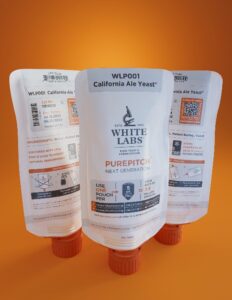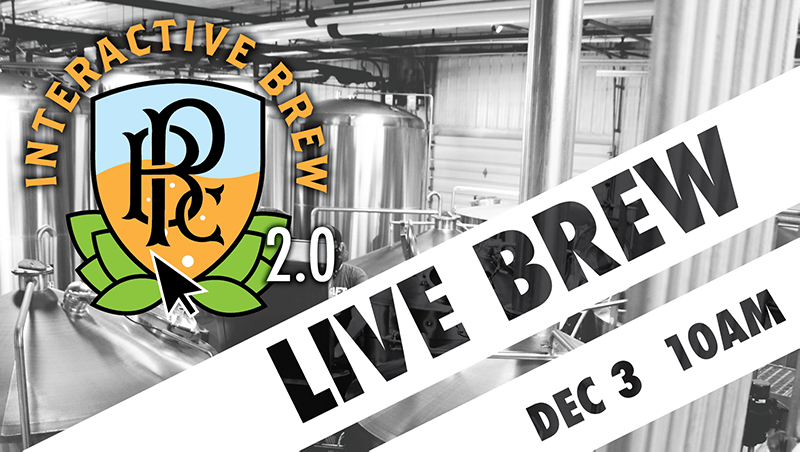Press Release:

New Homebrew Size Features Resealable Cap and Double the Cell Count for Foolproof Fermentation for Small-Scale and Homebrewers
Bringing the innovation of PurePitch Next Generation (PPNG) packaging to home and small-scale professional brewers, White Labs has reimagined its homebrew size yeast to feature a resealable cap, exceptional breathability, double the pitch rate and verifiable quality at a value brewers will love.
From the industry’s first pitchable liquid yeast to a complete revolution in the way it’s propagated and packaged, White Labs brings 27 years of exploration and innovation to its newest creation, PurePitch Next Generation (PPNG) Homebrew, delivering verifiable quality and consistency in easy-to-use packaging specifically for homebrewers.
“Homebrew is where White Labs began, and while we’ve continued to expand our range of products and packages over the last 27 years through our tireless spirit of innovation, we wanted to ensure we were keeping smaller brewers in mind when expanding our PurePitch Next Generation innovations to homebrewers,†says Chris White, founder and CEO of White Labs. “While this product is intended for homebrewers, we put the same rigorous quality standards into every batch, which results in professional quality yeast that can be used by professional and homebrewers alike.â€
Read more at White Labs
Homebrewing
NanoCon Online Registration

December 3 & 4, 2021
Big Ideas for Small-Scale Craft Brewing – Now in an Interactive Online Format
Learn from craft brewing industry experts with replays of live online sessions covering Brewery Operations, Business Operations & Sales, and Start-Ups.
Save $100 if registered by October 11, 2021 for NanoCon Online Early registration.
Register for 2021 NanoCon Online
Homebrewers! Are you ready for Fall?

Fall and Winter are coming. Let’s get you ready to brew!
Quality matters. Our high quality home brewing equipment is made of 304 stainless steel, is 100% sanitary, and built to last. Check out these IN STOCK home brewing favorites.
Stout Tanks & Kettles
Livestream Brewing of Perrin’s Interactive Brew 2.0 tomorrow
Perrin Brewing Company to Livestream Brewing of Interactive Brew 2.0
Press Release

You Chose Perrin’s Next Beer, & Now You Can Watch Them Brew It!
Comstock Park, Mich. (December 2, 2020) Over the past few weeks, voters have determined the style and ingredients of Perrin’s next beer release through the second ever Interactive Brew project. Beer lovers are invited to view a special livestream event on December 3 at 10 a.m. EST to watch Perrin’s brewing team craft this special, crowd-sourced brew. Homebrewers can follow along at home with materials provided by Perrin.
The Interactive Brew 2.0 project kicked off on November 13 and allowed the craft beer community to weigh in on aspects of Perrin’s next brew, including style and sub-style, flavor elements and the name of the beer. According to the results, Perrin’s next beer will be a Stout with chocolate, caramel and coconut. The project follows the initial Interactive Brew, which took place earlier this year, resulting in Self S’More-antine, a Russian Imperial Stout.
The name of the beer is still being determined, so click here to pick your favorite on or before Friday, December 4.
Visit Youtube here or tune into Perrin’s facebook page for the behind-the-scenes livestream event at 10 a.m. EST on December 3. Viewers are encouraged to come prepared with questions for Perrin’s brewers. Homebrewers can find detailed brewing instructions and a printable recipe here. Stay tuned for beer release information coming soon.
Homebrew Projects to Tackle While We Wait
Homebrew Projects to Tackle While Social Distancing
Since going out for a beer simply isn’t an option right now. ( Please support local breweries by ordering delivery online, if you’re comfortable with it!) But, it’s a great time to make your own beer.
Open up that kit that’s been sitting in the closet gathering dust or order everything required by online delivery — and while you wait for gumption, inspiration, or shipping, Vinepair has plenty of reading recommendations to keep you occupied, too.
Via Vinepair
Does Your Homebrew Taste Like Homebrew?
Four Reasons Your Homebrew Tastes Like Homebrew (and How to Prevent It)
The best part of being a homebrewer is sharing your beer. But, if you’ve noticed your friends don’t finish their pints, or give it a generic, “It’s good!†for feedback, you may be making one of these very common mistakes. Here are four reasons your homebrew might be subpar, and what you can do about it.
Via Vinepair
Iron Hill Brewery Invites Homebrewers to ‘Brew with a Legend’
Registration for Regional Beer Competition Opens on Monday, October 28th
Iron Hill is launching Brew with a Legend, a regional beer competition where homebrewers will vie for the opportunity to brew their signature recipe with craft beer pioneer and Iron Hill’s co-founder, Mark Edelson.
Via Iron Hill Brewery
AHA Big Brew May 4th
National Homebrew Day was designated by Congress May 7th in 1988. The American Homebrewers Association (AHA) created the Annual Big Brew event to celebrate National Homebrew Day around the world. Big Brew happens each year on the first Saturday in May. Anyone can host a Big Brew event, so invite your family and friends, and join in the global celebration.
Don’t miss the simultaneous toast at 1:00 p.m. ET, 12:00 p.m. CT on May 4, 2019!
Join the celebration and attend a nearby event: https://www.homebrewersassociation.org/aha-events/national-homebrew-day
Same Beer Brewed On $1,500 And $150,000 Equipment
Guy Brews The Same Beer On $1,500 And $150,000 Equipment
What Is the Solera Brewing Method?
Imagine barrels of beer, stacked as far as the eye can see, row upon row of wooden casks tenderly nurturing their contents as they age over years. It’s a lovely image, isn’t it? Now imagine that–every once in a while–your friendly neighborhood brewer cracks open the eldest barrels of their generation, drains portions of their liquid bounties, and then tops them off with beer from the adolescents of the bunch. The drained beer is bottled. The elder barrels get a shot of youthful vigor in the arm. The adolescent barrels get a top off from the older barrels. The brewer’s thirsty patrons top off their glasses. The circle of barrel-aging beer life continues. Everybody’s happy.
Weekend Beer TV: Deep Roots. A Pioneers Story.
For six generations and counting, the family farms that make up Yakima Chief Hops have been driven by the desire to help the entire community thrive by constantly improving beer’s greatest ingredient, the hop.
It’s that time of year again! No, not Halloween, “Learn to Homebrew Day!”
Press release from AHA:
November 3rd is the 20th Annual ‘Learn to Homebrew Day’
Beginner, Hobbyist and Professional Brewers from All Over the World to Participate
Boulder, Colo • October 23, 2018—On November 3, the American Homebrewers Association®(AHA)—which this year is celebrating its 40th anniversary—hosts the 20th annual Learn to Homebrew Day, an opportunity for homebrewers to draft their non-brewer friends and family to learn how to make beer at home. Hundreds of lively, educational events are held at homes, breweries, shops and clubs worldwide. Over 300 local celebrations and more than 4,000 participants are expected for this year’s celebration both in the U.S. and abroad.
“This year, we celebrate 40 years of the AHA, and 20 years of Learn to Homebrew Day. In 1999, Learn to Homebrew Day was established to promote the most rewarding and delicious activity of all time—homebrewing. And there’s never been a better time to give it a try,” said Gary Glass, director, American Homebrewers Association. “Each year, it’s gratifying to see so many beginners, hobbyists and professionals coming together. What’s also gratifying? Tasting your very own brew.”
(more…)
Free Homebrew Recipe Book — courtesy of BrewDog
I had no idea that BrewDog produced and updated yearly a recipe book with all of their past recipes in it. Here’s the latest one DIY Dog 2018, a 300+ page catalog of BrewDog beer recipes tailored to 5 gallon batches.
Weekend Video: How Beer Saved the World
https://vimeo.com/23278902
Link: Brut IPA: The Best New Thing in Beer or Passing Fad?
via October:
“Clean, bright and modern.†That’s how Samantha Lee, co-founder of the Hopewell Brewing Company in Chicago, describes her brewery’s ethos, from the balance of its beers to the airy, inviting taproom. It’s also an apt description of Brut IPA, the latest phenomenon in American craft brewing’s seemingly never-ending love affair with the India Pale Ale.
Barely a year ago, Brut IPA began as a process innovation in a San Francisco brewpub. Kim Sturdavant of Social Kitchen and Brewery took a brewer’s enzyme called amyloglucosidase—an amylase enzyme typically used either for producing light beer or for lightening the body of big, viscous stouts—and added it to the recipe of a typical 7% ABV IPA. The process produced something new in itself: An IPA with zero residual sugar, restrained bitterness, lively carbonation and unparalleled drinkability. He called it the Champagne IPA, then later: Brut IPA.
